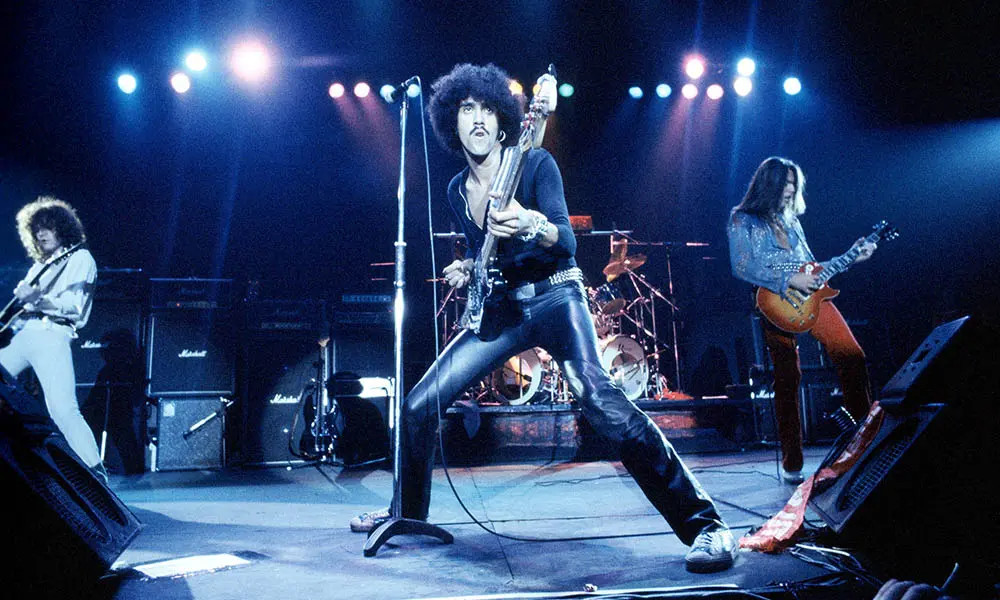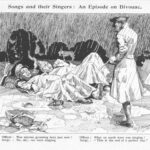When discussing bands that have truly shaped the landscape of rock and roll, Thin Lizzy rightfully earns its place among the titans. Fronted by the inimitable Phil Lynott, Thin Lizzy was more than just a band; they were a cultural force, delivering a unique blend of hard rock, poetic lyricism, and undeniable stage presence. Their album Live And Dangerous stands as a testament to their electrifying live shows, while their studio work traversed genres, incorporating elements of funk, ballads, and traditional Irish music, always stamped with their distinctive sound. Nominated for the Rock & Roll Hall Of Fame in 2020, Thin Lizzy’s legacy endures. Join us as we delve into 20 of their best songs, celebrating this remarkable Dublin band and their lasting impact on music.
 Thin Lizzy band portrait featuring Phil Lynott, Scott Gorham, Brian Robertson, and Brian Downey
Thin Lizzy band portrait featuring Phil Lynott, Scott Gorham, Brian Robertson, and Brian Downey
Photo: Fin Costello/Redferns
20: The Rocker
“The Rocker” bursts onto the scene as a quintessential early Thin Lizzy track, rightfully earning its spot as a standout from their 1973 album, Vagabonds Of The Western World. This aptly named song served as a blueprint for the band’s signature sound, a swaggering rock anthem that would become their calling card throughout the mid to late 1970s. Notably, “The Rocker” was one of the few tracks from their initial era to persist in their live sets even after the pivotal guitar duo of Brian Robertson and Scott Gorham stepped in, replacing original guitarist Eric Bell in 1974. It encapsulates the raw energy and stylish confidence that defined Thin Lizzy’s most celebrated period.
19: Killer On The Loose
“Killer On The Loose” remains, without a doubt, the most contentious song in Thin Lizzy’s discography. Released as a single in 1980, the edgy rocker unfortunately coincided with the intense manhunt for Peter Sutcliffe, infamously dubbed “The Yorkshire Ripper” by the press. Despite not being inspired by Sutcliffe, the timing led to media accusations that Phil Lynott was exploiting the horrific serial killings for artistic gain. This controversy didn’t prevent “Killer On The Loose” from achieving commercial success, reaching No.10 in the UK Top 40 during the autumn of 1980, but it forever linked the song with a dark chapter in British history.
18: Whiskey In The Jar
“Whiskey In The Jar” is a timeless traditional folk ballad narrating the tale of a highwayman’s betrayal by his love after he robs a government official. Its roots are deep within Irish folk music, popularized in the 1960s by The Dubliners. Phil Lynott was drawn to the song’s themes of romance and roguery, and while it deviated from Thin Lizzy’s typical hard rock sound, their powerful rendition became a breakthrough hit. In February 1973, Thin Lizzy’s version of “Whiskey In The Jar” granted them their first UK Top 10 hit and topped the Irish charts, introducing them to a wider audience and showcasing their versatility.
Whiskey In The Jar
Click to load video
17: Renegade
The Renegade album, released in 1981, marked Thin Lizzy’s penultimate studio effort and found the band navigating the shifting musical landscape of the early 80s. While musical trends were evolving, Thin Lizzy’s songwriting prowess remained sharp. The album’s highlights, including the driving “Hollywood (Down On Your Luck),” the Latin-infused “Mexican Girl,” and the poignant title track “Renegade,” demonstrate the band’s enduring ability to craft compelling songs. These tracks stand shoulder to shoulder with Thin Lizzy’s most celebrated work, proving their creative fire was far from extinguished.
16: She Knows
Though Nightlife, Thin Lizzy’s fourth album from 1974, might not possess the immediate impact of later albums like Jailbreak, it remains a highly underrated gem within their catalog. “She Knows,” the album’s opening track, exemplifies Thin Lizzy at their most accessible and pop-oriented. Beyond its catchy melody, “She Knows” holds significance as the first song co-written by Phil Lynott and guitarist Scott Gorham. Gorham noted in a 2013 interview with American Songwriter that Lynott actively encouraged band collaboration in songwriting from the outset, fostering a creative environment where everyone could contribute.
She Knows
Click to load video
15: Southbound
“Southbound,” a standout track from 1977’s Bad Reputation, offers a more reflective and narrative-driven side of Thin Lizzy. Phil Lynott’s lyrics vividly depict the life of a traveling musician, mirroring Thin Lizzy’s early experiences of constant touring and fleeting connections in pursuit of success. The song is both wistful and poetic, with lines like “So tonight after sundown, I’m gonna pack my case/Without a word, without a sound, disappear without a trace,” capturing the transient nature of life on the road. Scott Gorham’s melodic guitar work beautifully enhances the song’s introspective mood, making “Southbound” a fan favorite in live performances throughout the late 70s.
14: The Sun Goes Down
Thunder And Lightning, Thin Lizzy’s final studio album released in 1983, was recorded with a refreshed lineup, consisting of Lynott, Gorham, drummer Brian Downey, guitarist John Sykes, and keyboardist Darren Wharton. While the album leaned into a heavier, more metal-influenced sound than their classic era, it still showcased Thin Lizzy’s songwriting quality. In retrospect, Thunder And Lightning feels more like the start of a new phase than a farewell. While “Cold Sweat” and the title track achieved minor hit status, “The Sun Goes Down” stands out as the album’s emotional core. This introspective ballad, delivered with dignity and a sense of finality, is a powerful and poignant highlight of their later work.
13: Suicide
As evidenced by the July 1973 rendition found on the At The BBC collection, “Suicide” was a song extensively performed in Thin Lizzy’s early days, primarily as a showcase for Eric Bell’s blues-infused slide guitar prowess. For their 1975 album Fighting, Lynott and the band toughened up the arrangement, transforming “Suicide” into a harder-edged rocker. This revamped version provided the newly recruited guitar duo of Brian Robertson and Scott Gorham with an early platform to demonstrate their combined guitar firepower, signaling the band’s shift towards their signature twin-guitar attack.
Suicide
Click to load video
12: Johnny The Fox Meets Jimmy The Weed
“Johnny The Fox Meets Jimmy The Weed,” from the Johnny The Fox album, offers a glimpse into Thin Lizzy’s eclectic musical tastes. This unusually funky track was directly inspired by Phil Lynott’s appreciation for the Philadelphia soul group, The O’Jays, specifically their hit “For The Love Of Money,” which heavily influenced the song’s main riff. Scott Gorham recounted to Classic Rock magazine that Lynott would frequently play the funky riff during soundchecks. Brian Downey’s drumming then shaped the song, adding his unique funk-infused style. The song’s characters, described by Gorham as “part of a gang of cultured thieves,” were based on real individuals who were regulars at Lynott’s mother’s Manchester hotel, the Clifton Grange, adding a personal touch to the song’s narrative.
11: Do Anything You Want To
Black Rose: A Rock Legend, Thin Lizzy’s ninth studio album, is notable for being their only album to feature guitarist Gary Moore. This album, released in 1979, is packed with classic tracks and rightfully soared to No.2 on the UK charts. “Do Anything You Want To,” the album’s opening track, epitomizes the confident and energetic spirit of Thin Lizzy. As a single, it also broke into the UK Top 20, becoming an instant anthem. The song’s memorable and humorous promo video depicted Phil Lynott as a schoolteacher struggling to control a class of unruly students, played by his bandmates, adding a playful visual dimension to the song.
10: Sarah
“Sarah,” a tender and heartfelt ballad penned by Phil Lynott, should not be confused with the earlier Thin Lizzy song of the same name from 1972’s Shades Of A Blue Orphanage. This “Sarah” was written in celebration of the birth of Lynott’s daughter. Rumored to be initially intended for a solo project rather than the Black Rose album, it was recorded in a separate session with just Lynott, guitarist Gary Moore, and session drummer Mark Nauseef. Ultimately, it was included on Black Rose, and its radio-friendly appeal ensured it became a UK Top 30 hit as the album’s third single, showcasing a softer side of Thin Lizzy.
9: Warriors
“Warriors,” a standout from Thin Lizzy’s breakthrough Jailbreak album of 1976, is one of their most powerful and driving rock songs. Phil Lynott’s lyrics pay tribute to iconic musicians like Jimi Hendrix and Duane Allman, artists who lived life intensely and “made the conscious decision to take the thing as far as it can go.” This tribute inspired Thin Lizzy to deliver one of their most dynamic performances. Scott Gorham emphasized in a 2013 American Songwriter interview the guitar-centric nature of Thin Lizzy’s music, noting, “That’s what’s so cool about being a guitar player in Thin Lizzy. Most of the songs are guitar-driven. They are made to be able to solo over.”
Warriors
Click to load video
8: Jailbreak
“Jailbreak” instantly announces itself as a Thin Lizzy classic with its unforgettable signature riff, dueling lead guitars, outlaw-themed lyrics, and anthemic chorus. Now a staple of classic rock radio, this 1976 hit has solidified its place as one of Thin Lizzy’s most enduring songs. Its influence is evident in the numerous covers by artists ranging from Bon Jovi and Anthrax to former Lizzy guitarist Gary Moore. “Jailbreak” is a definitive Thin Lizzy track, capturing the band’s raw energy and melodic prowess.
7: Rosalie
“Rosalie,” originally written and performed by Bob Seger, is a tribute to Rosalie Trombley, the influential music director at Windsor, Ontario radio station CKLW-AM, a leading Top 40 station in the 60s and 70s. Thin Lizzy recorded a high-energy studio version for their 1975 album Fighting. However, the band’s electrifying live rendition of “Rosalie” from the 1978 album Live And Dangerous is widely considered the definitive version. This live performance even incorporates a brief but thrilling snippet of Jailbreak‘s “Cowboy Song,” further enhancing its impact.
6: Waiting For An Alibi
“Waiting For An Alibi,” the lead single from Black Rose, pulses with a punk-infused energy. Phil Lynott’s lyrics paint a vivid cinematic narrative (“Valentino’s got a bookie’s shop and what he takes/He gives for what he’s got”), complemented by a catchy call-and-response chorus. The song provides ample space for guitar interplay between Scott Gorham and Gary Moore, who trade impressive guitar lines. With its punchy, direct, and dynamic classic rock anthem qualities, “Waiting For An Alibi” achieved significant radio airplay, reaching No.9 in the UK charts in early 1979.
5: Still In Love With You
“Still In Love With You” is undeniably Thin Lizzy’s greatest ballad. Initially demoed in early 1974 by Phil Lynott, Brian Downey, and Gary Moore, this song played a crucial role in securing Thin Lizzy’s contract with Polygram Records that same year. The official studio version appeared on the Nightlife album in November 1974, featuring a duet between Lynott and guest vocalist Frankie Miller. However, “Still In Love With You” truly shines in its live performances. The extended eight-minute version featured on Live And Dangerous, enriched by Brian Robertson’s exquisite guitar work, is widely regarded as the definitive and most emotionally resonant rendition.
4: Don’t Believe A Word
Concise and incredibly catchy, “Don’t Believe A Word,” the signature hit from Johnny The Fox, delivers its message with remarkable efficiency in just two minutes and twenty seconds. Its commercial appeal was undeniable, peaking at No.12 in the UK charts. Interestingly, this punchy anti-love song (“Don’t believe me if I tell you/Especially if I tell you that I’m in love with you”) originated as an acoustic ballad reminiscent of Ben E King’s “Stand By Me.” It was transformed when Brian Downey developed the song’s distinctive shuffling rhythm and Brian Robertson introduced the sharp signature riff, completely reinventing the arrangement.
Thin Lizzy – Don’t Believe A Word
Click to load video
3: Emerald
“Emerald,” the spectacular closing track of Jailbreak, allowed Phil Lynott to fully express his deep pride in his Irish heritage. The song’s fiery lyrics (“Down from the glens came the marching men/With their shields and their swords/To fight the fight they believed to be right/Overthrow the overlords”) are among the most vivid and memorable in his songwriting catalog. Musically, “Emerald” is a tour de force. Scott Gorham highlighted in a 2013 Classic Rock interview that “Emerald” marked the beginning of his special guitar chemistry with Brian Robertson. He explained, “It was the first time that Brian Robertson did the bounce off lead guitar thing where he starts, I start… the back and forth. That was kind of a launching pad for that style of writing between the two guitarists.”
2: Dancing In The Moonlight
“Dancing In The Moonlight” showcases Thin Lizzy’s unique ability to blend hard rock with unexpected lightness and sophistication, a quality few other 70s hard rock bands possessed. This enduring 1977 hit is a nostalgic reflection on teenage adventures in Dublin, paying homage to Phil Lynott’s long-standing admiration for Van Morrison’s blue-eyed Celtic soul. The song’s wonderfully smooth backing track features seductive saxophone from Supertramp’s John Helliwell, alongside a masterful guitar solo from Scott Gorham, creating a truly distinctive and memorable sound.
1: The Boys Are Back In Town
Jailbreak is such a strong album that at least half of its tracks could easily be considered among Thin Lizzy’s best songs. However, when it comes to the single track most synonymous with Phil Lynott and Thin Lizzy, “The Boys Are Back In Town” is simply unmatched. Overflowing with swagger and pure joie de vivre, this timeless rocker, referencing Manchester criminals The Quality Street Gang and patrons of LA’s famous Rainbow Bar And Grill, is Lynott’s ultimate tribute to masculine camaraderie and adventure worldwide. “The Boys Are Back In Town” was a game-changer for Thin Lizzy, breaking into the UK Top 10 and propelling them to transatlantic success, solidifying their place in rock history.
The Boys Are Back In Town
Click to load video
Explore more of Thin Lizzy’s incredible music and discover the stories behind their iconic album covers.


